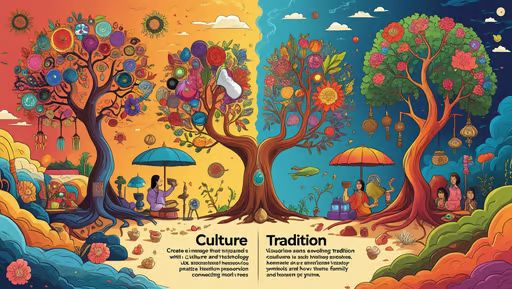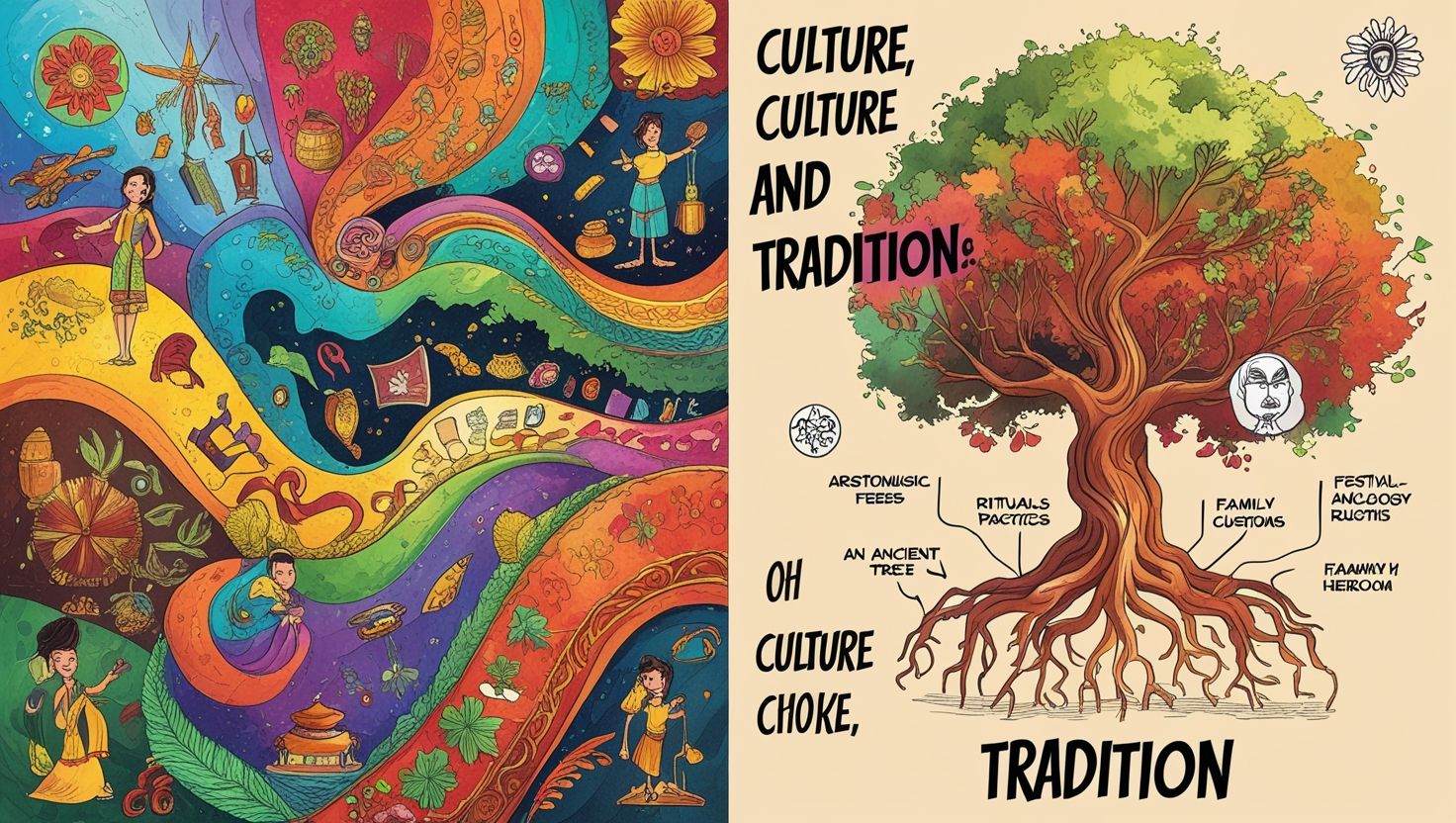Culture vs. Tradition: Differences and Interconnections, Culture and tradition are two concepts that are often used interchangeably, yet they hold distinct meanings and implications. Both play a significant role in shaping societies, influencing behaviors, and preserving the identity of communities. However, understanding the differences between culture and tradition, as well as their interconnections, is essential to appreciate how they contribute to the fabric of human life. This article explores the definitions, characteristics, and relationships between culture and tradition, highlighting their significance in a globalized world.
Defining Culture and Tradition
Culture is a broad and dynamic concept that encompasses the shared beliefs, values, customs, practices, arts, and social behaviors of a group of people. It is the collective expression of a community’s way of life, including its language, religion, cuisine, music, and art. Culture is not static; it evolves over time as societies interact, adapt, and innovate. It is influenced by historical events, technological advancements, and globalization, making it a living, breathing entity that reflects the current state of a society.
Tradition, on the other hand, refers to specific practices, rituals, or beliefs that are passed down from one generation to the next. Traditions are often rooted in history and are seen as a way to preserve the past. They are typically more rigid and resistant to change compared to culture. Traditions can include holidays, ceremonies, family customs, or religious practices. They serve as a link between the past and the present, providing a sense of continuity and identity.
Key Differences Between Culture and Tradition
- Scope and Flexibility
Culture is a broader concept that encompasses a wide range of elements, including traditions. It is flexible and adaptable, evolving with societal changes. Tradition, however, is narrower in scope and tends to be more fixed. While culture can absorb new influences, traditions often resist change to maintain their authenticity. - Evolution vs. Preservation
Culture evolves over time as societies interact and adapt to new circumstances. For example, the rise of digital technology has significantly influenced modern culture, from communication styles to entertainment. Traditions, however, are focused on preservation. They are often upheld to honor the past and maintain a connection with ancestors. - Individual vs. Collective Expression
Culture is a collective phenomenon that represents the shared identity of a group. It is influenced by the contributions of many individuals over time. Traditions, while also collective, are often practiced on a more personal or familial level. For instance, a family may have its own traditions that are distinct from those of the broader community. - Function and Purpose
Culture serves as a framework for understanding the world and guiding behavior. It shapes how people think, communicate, and interact. Traditions, on the other hand, often serve a symbolic or ceremonial purpose. They are used to mark important events, celebrate heritage, or reinforce social bonds.

The Interconnection Between Culture and Tradition
While culture and tradition are distinct, they are deeply interconnected. Traditions are a subset of culture, representing the tangible expressions of cultural values and beliefs. For example, the tradition of celebrating Thanksgiving in the United States reflects the cultural values of gratitude, family, and community. Similarly, the tradition of wearing specific attire during religious ceremonies is an expression of cultural identity and faith.
Traditions also play a crucial role in preserving culture. They act as a bridge between generations, ensuring that cultural knowledge and practices are not lost. For instance, traditional storytelling in many indigenous communities serves as a means of passing down cultural history, values, and wisdom.
At the same time, culture influences how traditions are practiced and interpreted. As cultures evolve, traditions may be adapted to fit contemporary contexts. For example, the tradition of marriage has undergone significant changes in many societies, reflecting shifts in cultural attitudes toward gender roles and relationships.
The Role of Culture and Tradition in Modern Society
In today’s globalized world, the interplay between culture and tradition has become increasingly complex. Globalization has led to the blending of cultures, creating new hybrid forms of expression. This has also resulted in the erosion of some traditions, as people adopt new practices and lifestyles. However, there is also a growing movement to preserve and revive traditions as a way of maintaining cultural identity in the face of homogenization.
For example, many communities are working to preserve endangered languages, traditional crafts, and indigenous knowledge systems. These efforts highlight the importance of traditions as a source of cultural pride and resilience. At the same time, modern culture continues to evolve, incorporating new ideas and innovations while still drawing on traditional roots.
Challenges in Balancing Culture and Tradition
One of the challenges in modern society is finding a balance between preserving traditions and embracing cultural change. While traditions provide a sense of continuity and identity, they can also become outdated or restrictive. For instance, some traditional practices may perpetuate gender inequality or other forms of discrimination. In such cases, it is important to critically evaluate traditions and adapt them to align with contemporary values.
Similarly, the rapid pace of cultural change can lead to a sense of disconnection or loss. As people adopt new technologies and lifestyles, they may feel detached from their cultural roots. This underscores the need for efforts to preserve and celebrate traditions while also allowing culture to evolve.
Conclusion
Culture and tradition are two sides of the same coin, each playing a vital role in shaping human societies. While culture is a dynamic and evolving force that reflects the current state of a community, tradition serves as a link to the past, preserving the knowledge and practices of previous generations. Understanding the differences and interconnections between culture and tradition is essential for appreciating their significance in our lives.
In a world that is increasingly interconnected, it is important to strike a balance between preserving traditions and embracing cultural change. By doing so, we can honor our heritage while also adapting to the challenges and opportunities of the modern world. Ultimately, both culture and tradition contribute to the richness and diversity of human experience, reminding us of who we are and where we come from.

9 thoughts on “Culture vs. Tradition: Differences and Interconnections”
Comments are closed.